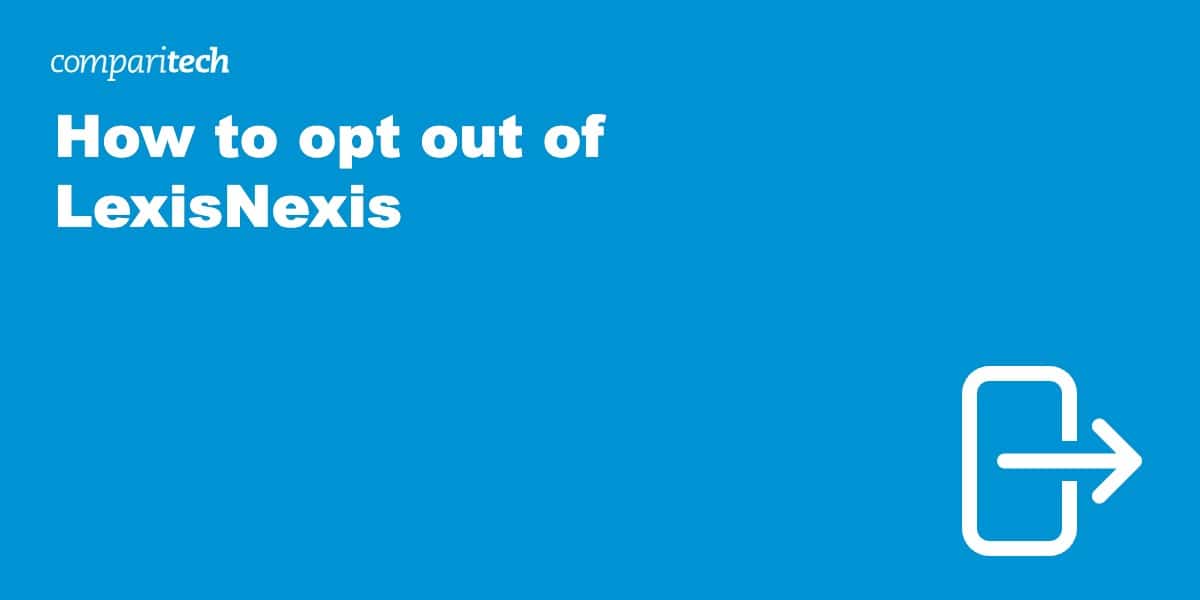There are dozens, if not hundreds, of people search sites on the internet like LexisNexis. These sites allow anyone to look up your data at any time. Some of the information public record search engines have on you may include your name, age, address, and phone number. Those with criminal records may even have their arrest record and booking photo published online for all to see.
People search sites can have some use, particularly for those looking to re-connect with family and friends. However, it’s fair to say that public record search engines can also be used by those with more malicious intentions, be it to run some sort of scam, or for cyberstalking. LexisNexis is one such public records search site. In this post, we’ll explain more about what it is, what it does, and how you can opt out.
What is LexisNexis and what does it do?
LexisNexis is a service that scrapes billions of publicly-available records and makes them available to anyone willing to pay. What’s really concerning from a privacy perspective is that its proprietary LexID system can reveal connections between people and places, even if they’re not officially recorded anywhere. Whether or not that algorithm is 100 percent accurate (which is extraordinarily unlikely), it’s still a major intrusion into your privacy, and gives complete strangers in-depth knowledge about your life, financial position, and routine.
To make matters worse, this is an opt-out system. In other words, LexisNexis will automatically share your information unless you tell it not to. Below, we’ll explain how to delete your details from LexisNexis once and for all. This is more difficult than you might think, but still possible, and something we strongly recommend.
Opting out of LexisNexis will not force other people search sites to take down your profile. You have two options: either contact each site individually and ask them to delete your information, or automate the process using a data-removal tool. Here are a few of our favorites:
- Incogni: Low-cost service that sends automated takedown requests to several major people search sites. Very easy to use. Works in Europe and North America.
- DeleteMe: Comprehensive protection for the whole family. Offers live chat and lets users request a takedown if their information is on a site that’s not covered automatically
- PrivacyBee: A US-only service that cites state-specific laws to better tailor your data-removal requests. Slightly more expensive but supports over 300 data brokers.
Our top data-deletion tool: Incogni
Apps Available:
Website: https://www.incogni.com
Surfshark is best-known for creating a fast, beginner-friendly VPN. The company branched out recently with the launch of its own antivirus program and, of course, Incogni. This service automatically contacts 180+ data brokers, asks them to delete your information, and escalates complaints to governing bodies if your requests are ignored or wrongfully denied.
So why choose Incogni over its competitors? First off, it works in a higher number of places, allowing more users to take back control of their data. It’s also extremely straightforward: you can just sign up, sit back, and let Incogni get to work.
For reasons we’ll discuss below, Incogni can’t remove you from LexisNexis automatically. It does, however, work with major people search sites like Whitepages, Pipl, and Nuwber. Here’s how to get started:
- First, you’ll have to sign up for Incogni. Plans start at $12.99 USD per month, though you can currently get a year of coverage for 50 percent off.
- Fill in the relevant information and allow Incogni to submit takedown requests for you
- The service will immediately start sending deletion requests to major data brokers
- After a few days, you should start to notice completed requests. Most of the organizations contacted should have deleted your data within the first month
- Incogni will continue checking back with previously-contact brokers to make sure they haven’t reacquired your info. Additionally, it’s always expanding its list of supported brokers and websites to provide the highest level of protection possible.
BEST DATA-REMOVAL TOOL:Incogni is a hassle-free way to remove your information from intrusive people search sites. There’s even a 30-day money-back guarantee so you can try it risk-free.
How to opt out of LexisNexis
LexisNexis has two levels of reporting: one for the general public and one for organizations that meet its stricter credential requirements. Anyone can have their data deleted from the first tier of search results by submitting an Information Suppression request. However, to be removed from the second tier, you’ll have to provide evidence that you’re a victim of identity theft or at risk of physical harm as a result of having your information visible.
Follow these steps to ask LexisNexis to delete your profile:
- Visit LexisNexis’ opt out page
- Click Next twice, then choose I do not want my information shared. Alternatively, if you’re eligible and would like to have your data removed from the more comprehensive searches as well, choose the appropriate category (such as I am a victim of identity theft)
- If you selected one of the more specific categories, you’ll now be asked for proof. This might be a police report number, your job title and agency, or other details of how you’re at risk. You can also upload attachments here if you’d like
- On the next page, enter your full name. You can also type in your Social Security Number, but this is entirely optional
- Enter your address on the following page
- Finally, you’ll be asked for your contact details. Just enter your phone number, email address, or home address, then click Confirm Request
- On the last page, you’ll be given a confirmation number. Write this down and keep it somewhere safe – you’ll need it if you want to contact LexisNexis about your request
Concerned about having your personal information shared online? In that case, you might want to try out an identity theft protection service. These monitor your accounts and alert you to any breaches, unauthorized login attempts, or credit applications made in your name.
Why should I delete my data from LexisNexis?
LexisNexis is one of the more comprehensive people-searching tools out there. In fact, it’s frequently used by private investigators and law enforcement. Further, it recently signed a multi-million dollar contract with Immigrations and Customs Enforcement (ICE) despite having an extensive set of blog posts on its own website about the organization’s failings and abuses of power.
Of course, LexisNexis’ data could be used to discriminate against you even if you’re a law-abiding citizen. The service’s terms of use forbid using it to determine eligibility for insurance, employment, or government benefits, but there’s really nothing stopping people from doing this. What’s more, the chances of you proving that they did are effectively non-existent.
LexisNexis provides subscribers with a huge range of sensitive information including their target’s:
- Full name
- Current and past addresses
- Social Security Number
- Date of birth
- Phone numbers and email addresses
- Criminal record
- Education and employment history
- Lien, bankruptcy, and property purchase history
- Vehicle records and any licenses they hold
- Business and credit history
LexisNexis: Frequently Asked Questions
What are the privacy risks associated with LexisNexis?
LexisNexis and sites like it effectively make money by doxxing people. It’s true that only accredited organizations can view the highest level of detail about a person, but even the basic report (that’s available to anyone) includes plenty of data that could be used to target you.
Let’s say you’re trying to avoid an abusive partner. For a few dollars, they can find out exactly where you live and how to contact you. Alternatively, they could show up at your workplace, report fake crimes at your address, steal your identity, or simply cyberstalk you.
Why do I get an error when I try to opt out of LexisNexis?
LexisNexis operates in multiple countries, but if you try to visit its opt-out page from outside of the US, you’ll see a “Secure Connection Failed” error. In short, if you realize your profile has put you in danger while traveling outside of the country, there’s nothing you can do about it.
There is a workaround, though. VPNs allow you to change your IP address, making it look like you’re browsing the web from another country entirely. Simply sign up and choose an American server to submit a takedown request as though you were still at home. Most major VPN providers offer a money-back guarantee too, so you can just claim a refund when you’re done.
What’s the best way to limit the amount of my personal info that’s online?
The first step to reclaiming your digital privacy is ensuring that the information that’s already out there can’t be shared. This might involve submitting data-deletion requests to popular people search sites, locking down your social media accounts, or removing anything that could identify you from personal websites.
Next, you’ll have to break the cycle of data-collection. There are plenty of free tools designed to block tracking cookies and help you browse anonymously, so we’d suggest taking advantage of them. You may also want to create new email addresses, delete unused accounts, and consider whether you’re oversharing online. For a quick rundown of where to start, check out our beginner’s guide to cybersecurity.








